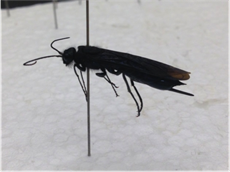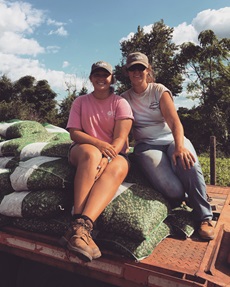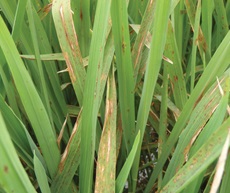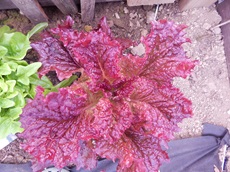Sigma Xi 2017 Student Research Showcase
Agricultural, Soil, & Natural Resources
 Sirex Woodwasps and Their Fungal Symbionts in Alabama Forests
Sirex Woodwasps and Their Fungal Symbionts in Alabama Forests
Andrea C. Wahl,Auburn University
Sirex noctilio is a wood wasp species native to Europe that has been identified as invasive in the southern hemisphere and northeastern United States where it has caused significant economic and ecological damage, and mortality of previously healthy trees. In this study, three trapping sites were set up in a longitudinal gradient throughout the state to sample for native and invasive woodwasps.
 Pine Decline Insects and Ecology
Pine Decline Insects and Ecology
Jessica Ahl, Auburn University
Southern pine decline is a disease complex that attacks the roots of stressed pine trees in the southeastern United States. Healthy trees become predisposed to bark-feeding beetles and weevils, and these insects introduce fungi into the roots as they feed, including Leptographium, Grosmannia, and Ophiostoma species. These fungi occlude xylem, blocking water uptake and staining the wood blue. In this study, we investigate the effects on insect populations from one of these species that has been associated with decline: Leptographium terebrantis.
 Impact of Leptographium terebrantis on Loblolly Pine Trees in Naturally Regenerated Forest
Impact of Leptographium terebrantis on Loblolly Pine Trees in Naturally Regenerated Forest
John Mensah, Auburn University
A study was designed to evaluate varying L. terebranstis inoculum load levels in loblolly pine and its influence on the trees physiological process to impact growth.
 Response of Dryland Peanut Cultivars to Herbicide Tank-Mixtures Utilizing Paraquat
Response of Dryland Peanut Cultivars to Herbicide Tank-Mixtures Utilizing Paraquat
Kayla Marie Eason, University of Georgia
Georgia is a leading producer of runner-type peanut (Arachis hypogaea L.). Paraquat tank-mixtures are effective and economically used to improve yield while lowering the potential for herbicide weed resistance. Experiments conducted in 2016 determined the effects of herbicide tank-mixes using paraquat on runner-type peanut cultivars under dry-land conditions.
 Characterization of Root Pathogenicity of Rice Blast Fungus Magnaporthe oryzae Using Spatial Science and Molecular Biology
Characterization of Root Pathogenicity of Rice Blast Fungus Magnaporthe oryzae Using Spatial Science and Molecular Biology
Navami Jain,Myers Park High School
My project investigates root pathogenicity of a fungus Magnaporthe oryzae by combining applications of molecular biology and spatial science.
 Bitter-taste Phenotype and Glucosinolate Profile Determine Perceived Bitterness of Brassica oleracea Crops
Bitter-taste Phenotype and Glucosinolate Profile Determine Perceived Bitterness of Brassica oleracea Crops
Nikhita Vemulapalli, North Carolina School for Science and Math
I investigated how the chemical compounds known as glucosinolates affect the bitterness of cruciferous vegetables.
 Response of Loblolly Pine to Vascular Inhabiting Ophiostomatoid Fungi
Response of Loblolly Pine to Vascular Inhabiting Ophiostomatoid Fungi
Pratima Devkota,Auburn University
Loblolly pine is the most widely cultivated timber species, creating 110,000 jobs and contributing 30 billion dollars to the economy of the US South. Recently, bark-beetle vectored vascular-inhabiting fungi are the threat to sustainable loblolly pine forest management. To address these issues, objectives of my research are to; 1) screen the disease tolerant loblolly pine families (cultivars), 2) understand how the fungi and loblolly pine interact under drought conditions and 3) assess whether plant growth-promoting rhizobacteria (PGPR) can induce resistance of loblolly pine to these fungi.
 Sigma Xi Student Showcase Presentation on Forest Soil
Sigma Xi Student Showcase Presentation on Forest Soil
Shrijana Duwadi, Auburn University
Study of soil microbial biomass and soil moisture in loblolly pine (Pinus taeda) stand.
 BMolecular-Based Selection for Anthocyanin in Lactuca sativa
BMolecular-Based Selection for Anthocyanin in Lactuca sativa
Sophia Swartz, Central Bucks South High School
The overall goal is to identify a minimally destructive, qPCR-based method allowing for rapid genotypic selection in lettuce seedlings.

The Effects of Soil Quality on Mimosa Strigillosa Tannin Production and Therefore its Ability to Inhibit the Growth of Staphylococcus Epidermidis
Valentina Ortega,American Heritage High School
In the following study, the effect of soil quality was tested on Mimosa Strigillosa tannin production and therefore its effects on the growth of Staphylococcus Epidermidis. The high-fertility group yielded extracts with the most tannin concentrations.